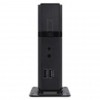ViewSonic SC-T35 SC-T35 / SC-T45 ViewSonic Device Management (English) - Page 59
Thin Clients
 |
View all ViewSonic SC-T35 manuals
Add to My Manuals
Save this manual to your list of manuals |
Page 59 highlights
Using ViewSonic Device Manager Managing All Your Clients 3. Click at the right top of the Available Clients pane. 4. The Select Clients window appears. A tree view of client groups and individual clients is provided in this window for specifying the applicable scope of this setting profile. 5. Click on arrows to expand the tree and click to select the desired client group or individual clients. • To select all clients under a client group, click to select the group. • To select multiple clients under a client group, Ctrl-click to select the desired clients. NOTE • The tree view of client groups and individual clients corresponds exactly to client groups and individual clients established under Thin Clients tab. For information on how to create client groups and add clients to a group, please refer to "3.4.3 Creating Client Groups" on page 43 and "3.3.3 Client Detection and Management" on page 35 separately. • A client can only be associated with a setting profile. If you associate a client with a new setting profile, it will be automatically removed from the old one. • Associating a client with a profile does not actually change the settings of the client. You need to push settings to the client for the change to take effect (a reboot may be required as well). For instructions on how to push settings to a client, please refer to section "3.4.15 Pushing Settings to Clients through Your Local Network" on page 61. 6. After completion, click OK to confirm the selection of applicable clients. 7. Click Save in the Profile Information pane to complete the specification of applicable scope. NOTE • Only a well defined setting profile is actually used for remote configuration of multiple clients. If the applicable scope of a setting profile is not specified, the profile (group configuration) doesn't affect any client. • From now on, we will call a client configuration set up by applying a shared setting profile a group configuration. 54















